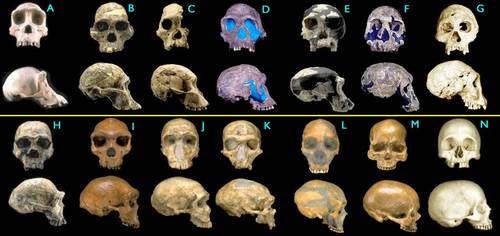I would like to know when did Species X turned into modern human and what is the evidence that one came from the other?"
First, you have to begin by understanding that the word "species" is a scientific construct which generally means: populations which do not normally interbreed in nature, but still physically can, on occasion.
The term "species" falls on a continuum from "breed" to "species" to "genus" to "family"... etc.
Where "breeds" (i.e., dogs) interbreed eagerly, "species" (i.e., different zebra species) do not normally interbreed in nature; and "genera" cannot be forced to interbreed, even in captivity -- i.e., African versus Indian elephants.
I'll cite again a great example of the distinction: Polar Bears were once considered a separate genus from Brown Bears (grizzlies), but were recently found to have produced viable hybrid offspring and so are now re-classified as different "species" within the "genus" Ursus.
With human beings: we now famously know of three other pre-human populations which may have been different "species" (meaning very little interbreeding) but possibly just different breeds of homo-sapiens.
Those three are Neanderthals (Europe), Denisovans (Siberia)and Floresiens (aka "Hobbits", Indonesia).
Two others are less well understood: Red Deer Cave People (China) and Idaltu's (Ethiopia).
Second, DNA analysis of Neanderthals and Denisovans shows them both to be slightly related to each other, and to modern humans, via interbreeding.
No results yet on the others.
Third, the fossil record is incomplete in the extreme.
Consider there are today roughly 5,000 species of mammals, but we have fossils of barely 50 mammals from, say, 10 million years ago.
So, what we don't know is still overwhelmingly greater than what we do know.
As for "missing links", here is a pretty good summary of pre-humans dating all the way back to near-chimpanzee days:

•(A) Pan troglodytes, chimpanzee, modern
•(B) Australopithecus africanus, STS 5, 2.6 My
•(C) Australopithecus africanus, STS 71, 2.5 My
•(D) Homo habilis, KNM-ER 1813, 1.9 My
•(E) Homo habilis, OH24, 1.8 My
•(F) Homo rudolfensis, KNM-ER 1470, 1.8 My
•(G) Homo erectus, Dmanisi cranium D2700, 1.75 My
•(H) Homo ergaster (early H. erectus), KNM-ER 3733, 1.75 My
•(I) Homo heidelbergensis, "Rhodesia man," 300,000 - 125,000 y
•(J) Homo sapiens neanderthalensis, La Ferrassie 1, 70,000 y
•(K) Homo sapiens neanderthalensis, La Chappelle-aux-Saints, 60,000 y
•(L) Homo sapiens neanderthalensis, Le Moustier, 45,000 y
•(M) Homo sapiens sapiens, Cro-Magnon I, 30,000 y
•(N) Homo sapiens sapiens, modern